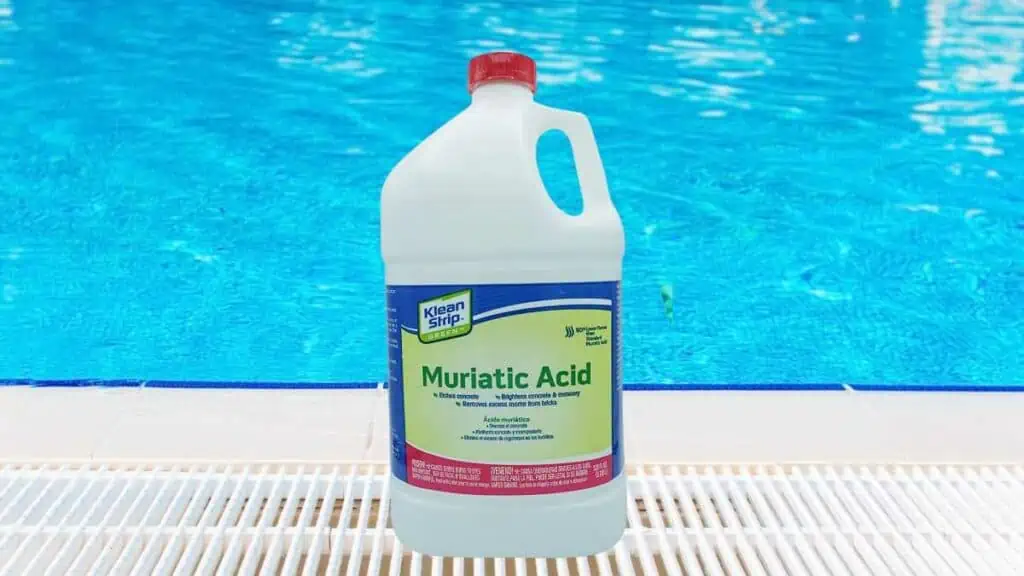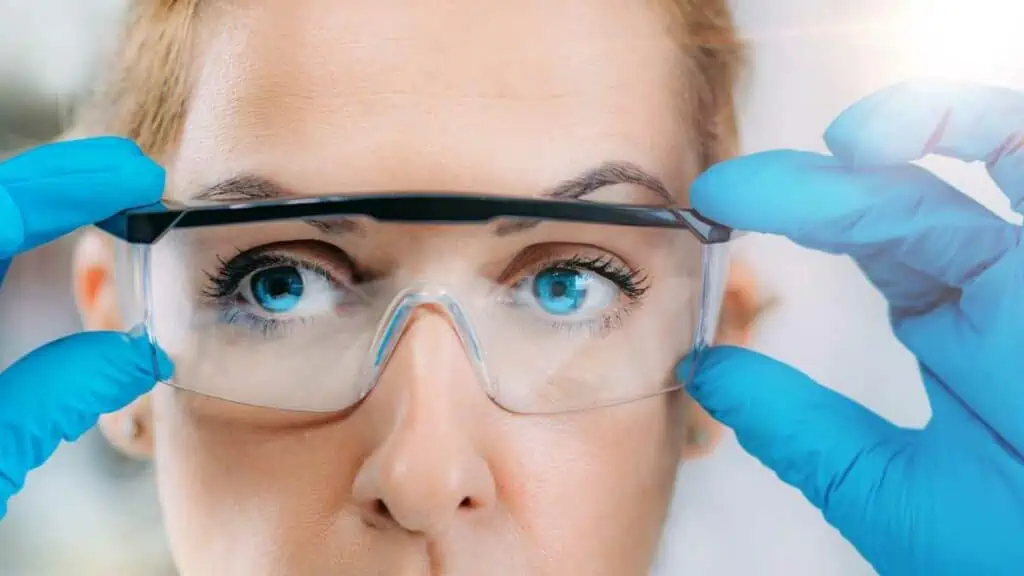Muriatic acid, also known as hydrochloric acid, is a commonly used chemical in swimming pool maintenance and cleaning.
It is normally used to lower the pH and total alkalinity levels in pool water to ensure that it is safe for swimming and to prevent the buildup of harmful bacteria. However, muriatic acid can be a dangerous and highly reactive chemical, so it is important to understand how to use it properly and safely.
In this article, we will provide clear information on what muriatic acid does for a pool, the key considerations for its use, and its benefits and potential drawbacks.

Quick Answer
Muriatic acid for pools, also known as hydrochloric acid, is commonly used for water pH balancing and surface cleaning. It effectively removes scale, mineral deposits, and stains from pool surfaces. However, caution is advised while handling this strong acid, as it should be diluted and used in well-ventilated areas with proper protective gear.
Why use muriatic acid in pools
The pH level of a pool is an important factor in maintaining a healthy and balanced pool environment. The ideal pH level is between 7.2 and 7.8.
- If the pH level is too low, the water can become corrosive and damage the pool and equipment.
- If the pH level is too high, the water can become cloudy and cause skin and eye irritation.
Muriatic acid lowers the pH level of pool water to bring it within the ideal range.
How muriatic acid adjusts pH level
Muriatic acid releases hydrogen ions into the pool water, decreasing the pH level.
The pH level measures the acidity or basicity of a solution and is measured on a scale of 0 to 14.
- A pH level of 7 is neutral
- A pH level of less than 7 is acidic
- A pH level greater than 7 is basic.
By adding muriatic acid to the pool water, the hydrogen ions lower the pH level, bringing the water closer to the ideal range of 7.2 to 7.8.
How much muriatic acid to lower pH in pool
How much muriatic acid to add to pool water to adjust the pH level depends on the size of the pool, the current pH level, and the desired pH level.
It is important to measure the pool’s pH level regularly using a test kit or test strips and to add the appropriate amount of muriatic acid.
Too much muriatic acid in pool water can cause the pH level to become too low, which can be dangerous for swimmers and damage the pool and equipment.
My Top Pick
This table shows how much muriatic acid to lower pH in pool that holds 10,000 gallons to reduce the pH down to 7.5:
| pH Level | Muriatic Acid (ounces) |
|---|---|
| 8 | 5 – 8 ounces |
| 9 | 10 – 16 ounces |
| 10 | 16 – 24 ounces |
| 11 | 24 – 32 ounces |
| 12 | 32 – 40 ounces |
| 13 | 40 – 48 ounces |
| 14 | 48 – 56 ounces |
For larger (or smaller pools), use the same proportion to lower the pH from 10 in a 25,000-gallon pool and add between 40 and 60 ounces (multiply by 2.5).
Although I have used muriatic acid at times, I rarely need to. This is mainly because I do not usually use liquid chlorine to shock my pool. Liquid chlorine has a pH of 13, likely increasing it and requiring muriatic acid to lower it again.
How to use muriatic acid in pool
It is important to always slowly add muriatic acid and test the water at intervals to ensure the desired pH level is reached and maintained. Adding too much muriatic acid can lead to a dangerous drop in pH, so it is always best to add it in small increments and monitor the water’s pH level regularly.
You should also avoid adding the acid directly to the pool, as it can cause skin and eye irritation. Instead, add the acid to a bucket of water and stir it in. Then, slowly pour it into the pool, walking around the edge as you do to distribute it evenly.
Run your pool pump to ensure the acid is mixed throughout the pool.
Safety when adding muriatic acid to pool

Proper handling and storage of muriatic acid
Muriatic acid is a highly corrosive and strong mineral acid, and it is essential to handle and store it properly to avoid injury. Store it in a cool, dry place away from flammable materials and keep it out of the reach of children and pets.
Never mix acid with any other chemicals.
Protective gear to wear when adding muriatic acid to the pool
Wear protective gear when adding muriatic acid to a pool to avoid skin and eye irritation. This can include gloves, eye protection, and a long-sleeved shirt. It is also important to avoid inhaling the fumes from the muriatic acid, as they can be harmful.
Precautions to take to avoid skin and eye irritation
If muriatic acid comes into contact with the skin, thoroughly wash it in clean water. If muriatic acid gets in the eyes, it is important to rinse them immediately with water for at least 15 minutes and to seek medical attention if necessary.
Using muriatic acid with a vinyl liner
If you have a vinyl-lined pool, you should use muriatic acid sparingly, as it may affect the liner, particularly if it is patterned.
If necessary, you should lower the pH using dry acid instead of muriatic acid.
Using dry acid vs muriatic acid
Dry acid is sodium bisulfate, which, as the name suggests, contains sulfates. Over time, sulfates can build up and start to attack the structure of your pool.
On the other hand, muriatic acid is chlorine-based and is also produced by the body as stomach acid. It will not adversely affect the pool’s structure and is typically cheaper than dry acid.
The importance of maintaining the pH level in a pool
The ideal pH range for pools
The ideal pH range for a swimming pool is between 7.2 and 7.8. This range is considered neutral and provides optimal conditions for swimmers and pool equipment.
When the pH level is within this range, the water is less likely to cause skin and eye irritation, and the chlorine in the water will be more effective at killing bacteria and other harmful substances.
Problems with low and high pH levels
If the pH level in a pool is too low, the water can become corrosive and damage the pool and equipment. This can lead to expensive repairs and decreased enjoyment of the pool. Additionally, low pH levels can cause skin and eye irritation, making it uncomfortable for swimmers.
On the other hand, if the pH level is too high, the water can become cloudy, reducing visibility and making it difficult to see the bottom of the pool. High pH levels can also cause the chlorine in the water to be less effective at killing bacteria and other harmful substances.
Summary
Can I use Klean Strip Muriatic Acid in my pool?” – yes! Klean Strip Muriatic Acid is a reliable choice for understanding how to use it in swimming pools. There are numerous uses of muriatic acid for pool maintenance. So, what does Muriatic Acid do for a swimming pool? Well, it is a powerful chemical that aids in pool cleaning. Whether you have an above-ground or in-ground pool, Muriatic Acid can tackle various pool issues. But what exactly does Muriatic Acid do in a pool? This acid helps to balance the pH levels, sanitizes the water, and removes stubborn stains or deposits. So, what does acid do for a pool? It plays a crucial role in maintaining your pool’s cleanliness and hygiene. However, following safety guidelines and using Muriatic Acid properly is vital to avoid any harm to yourself, others, or your pool.
Muriatic acid FAQs
How often should I add muriatic acid to my pool?
The frequency of adding muriatic acid to your pool will depend on several factors, such as its size, usage, and other chemicals. Generally, it’s a good idea to check the pH level of your pool once a week and add muriatic acid if necessary. You may need to add more often during hot, sunny weather when the pH level can rise quickly.
How long after adding muriatic acid can you swim?
It is safe to swim in a pool after adding muriatic acid, but you should wait at least 15 minutes for the chemical to mix correctly and then recheck the water’s pH level to ensure it’s within the ideal range of 7.2 to 7.8. If the pH level is still too high, you may need to add more muriatic acid and wait another 15 minutes before rechecking it.
Can too much muriatic acid be harmful to my pool?
Yes, too much muriatic acid can be harmful to your pool. If the pH level drops too low, it can cause skin and eye irritation and damage pool equipment and surfaces. It’s important to follow the manufacturer’s instructions and not add too much muriatic acid simultaneously. If you add too much, you can neutralize the excess acid by adding sodium carbonate (soda ash) to raise the pH level to the ideal range.
Does muriatic acid go bad?
Muriatic acid has a long shelf life, upwards of 5 years if stored properly. It may be that the container it is stored in could last for less time, so you should regularly check the muriatic acid you have stored. It should not be stored in sunlight if it is in a plastic bottle.
Does muriatic acid kill algae?
Muriatic acid will not directly kill algae when added to a pool. However, using it to balance the pH level will allow the chlorine in the pool to work correctly, and that will kill any algae.






Leave a Reply